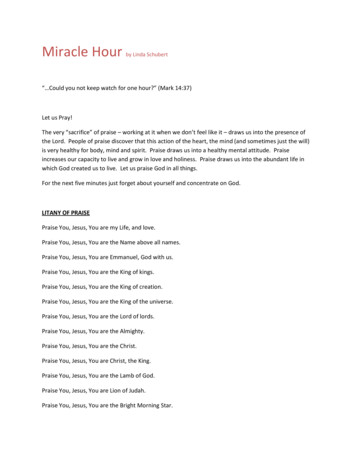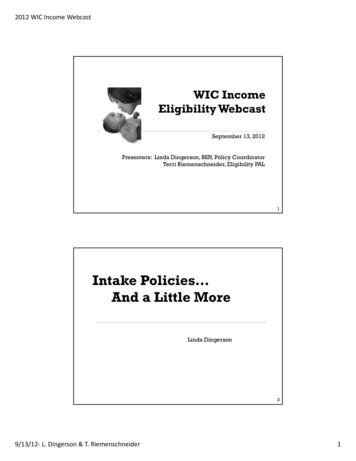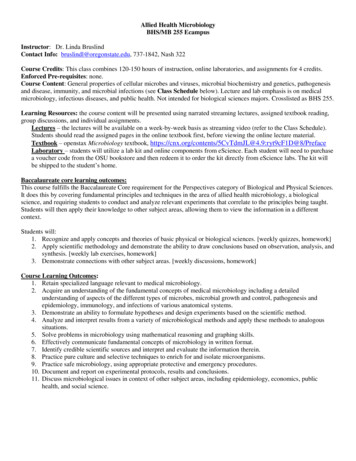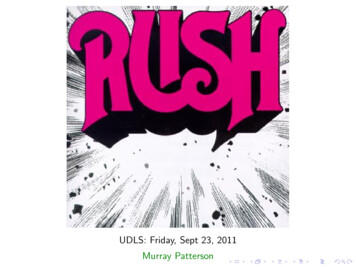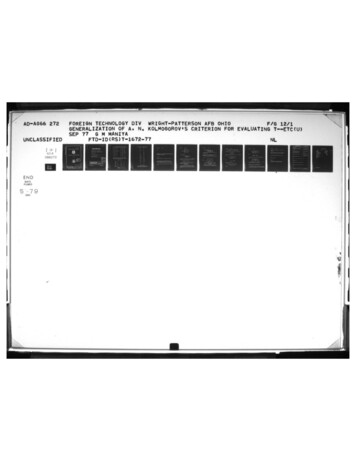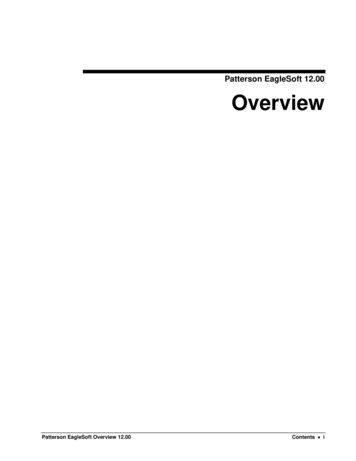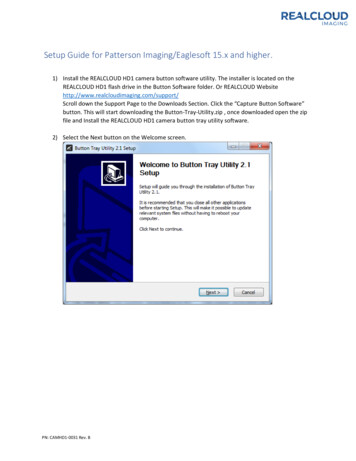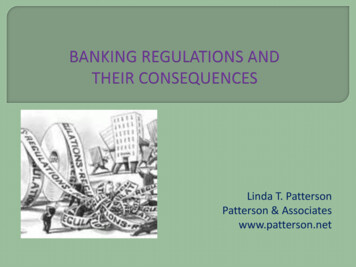
Transcription
Linda T. PattersonPatterson & Associateswww.patterson.net
Liquidity Whenand Leveragebanks pledge you collateral: They are loaning their own portfolio They reduce their access to the securities – liquidity They increase use of their securities – leverage Bankshave to reverse the potential impact2
Banksface a wall of worry Regulatory hurdles Compliance nightmares Regulationsgoals are admirable Manage through the next stress period
Basel III developed by the Bank for International Settlements established 1930 inBasel, Switzerland their goal is to help central banks with monetary and financialstability especially in stress periods.Strengthen regulation,supervision and riskmanagement in thebanking sectorImprove the bankingsector’s ability to absorbshocks arising fromfinancial and economicstressProtect the market and broadereconomy from the impact of anisolated stress event in a singlebankEnsure banks have reliable,stable sources of funding intimes of stability and stress
Liquidity Coverage Ratio Requires banks to hold highquality liquid assets (HQLA) Requires reserves to meet allliabilities in a 30 day stressscenario HQLA includes cash, reserves,government & corporate debtPotentially limits banks frommaking loans Net Stable Funding Ratio NSFR seeks to reduce a bank’sfunding horizon by promotinglonger term funding sources Reduces dependency on shortterm funding Encourages funding stability Aims to better assess funding risk
REGULATION, RATES AND OPPORTUNITYComposition of Required Capital through transition period to 2019Source: Board of Governors of the Federal Reserve System4
Globally Systemically Important Banks (G-SIB) “too big too fail” US G-SIBs placed under stronger regulations Additional regulations add pressure on short-term Non-operating deposit balances act against the bank Capital buffers range from 0% to -5.5% US method for G-SIB calculation varies from the BaselCommittee calculation by including Short-term WholesaleFunding (STWF); which adds further pressure on these banks’treatment of non-operating deposit balances
: Basel redefines how banks manage their balance sheetsincluding liquidity Added (1) Supplementary Leverage Ratio 6% non-risk based leverage ratio to back-up LCR and NS forlargest banks Added (2) Total Loss Absorbing Capital
Who are they?CitiBankJPMorgan ChaseMorgan StanleyBank of NY MellonGoldman SachsWells FargoBank of AmericaState StreetG-SIBS and their components being measured are:SizeInter-connectivenessComplexityCross jurisdictional activityShort term funding sources
A bank’s basic profitability goal is to earn more interest on itsbook of loans than it pays in interest on deposits Typically its loans to customers (assets) should balance itsdeposits (liabilities) Interest income minus interest expense shouldequal the net interest margin Basel III requires higher reserves therebyreducing interest income.
Theclassification of the balance has a directusability of funding for banks and their abilityto profit Ahigher % of non-operating balances areneeded for HQLA HQLA (Treasuries) provide liquidity but reduced returnEGespecially a traditional bank loan7
Increased demand for HQLA will reduce the supply available to serve ascollateral for Public Sector deposits Banks will carry significantly higher costs on public sector and non-operatingbalances vs. corporate operating balances Banks will likely encourage non-operating funding to appropriate off–balancesheet vehicles such as money market mutual funds in the form of sweepsFor every 100 mm in corporatedeposits-30 day run-off during event 25%-Required bank liquidity 25 mmFor every 100 mm in public deposits-30 day runoff during event 40%-Required bank liquidity 40 mm
PUBLIC ENTITIES Some deposits may no longer beattractive to some banks Holistic banking relationships willbe critical operational accounts are key Banks may channel excess non-operating liquidity intoalternatives Lower yields for excess liquidity islikely the new normalFOR BANKS Higher capital reserverequirements for all deposit types Collateralized public sector fundsand non-operating balances willrequire higher reserves Banks are being impacted byhigher capital requirements andhigher compliance costs
Publicentities are more costly and less desirableto banks due to regulations Public entities will need alternatives Banks can not afford large balances Why public entities? Fluctuating balances through the year Requirements for collateral High service demands High volumes Always repetitive and competitive bidding
Collateral FDICAlternativesCoverage Changes Moneymarket mutual fund use Sweepscan help Alternativeinvestments
Bankswill view alternatives on a cost basis Reduced Someamount of collateral available to pledgebanks will only offer FHLB letters of credit Increasedcost of collateral to the bank Banks may charge a collateral fee
Authorizedby law(2001) LOC from FHLB Regional Banks Securities cost about 10-12 bps. and a LOC 5 bps. What is a LOC? FHLB is a banker’s bank owned by the member banks Credit backing comes from the member banks Tenuous line to the Treasury Event of default conditions Time requirements for amount changes System stress
Define authorized collateral (in policy and RFP) “Obligations of the US Government, its agencies and instrumentalities,including mortgage backed securities andCMO passing the bank test and FHLB letters of credit” Optional: Preference given to pledged securities Monitored and maintained by the bank at all times. Reports monthly from custodian Toassure you get a bank bid/proposal add LOC as acollateral option Youcan prefer securities but authorize LOC toguarantee a bid18
Investmentoptions within the bank Investmentoptions through the bank Investmentoptions outside the bank
Effective when rates are higher than now Sweeps move funds out of the bank daily You are investing in a money fund security Reduces balances on which FDIC fees apply Investment in fund (security) eliminates collateral20
Banksare beginning to pass through FDIC fee Not all banks pass through – ask! - verify Basedon bank but basically 0.12% Higherbalances hurt on collateral and FDIC fee Knownby many names FDIC does not allow use of FDIC name for fee
Investing Yieldin securities outside bankscurve changes have createdopportunities
Onenot to worry about but to act on Based on type of account – a change in definitions All time and savings accounts 250,000 Includes NOW and money market accounts All demand accounts 250,000 Includes interest bearing and non-interest bearing Based on location of bank If the bank is outside the state all deposited are lumped together This has changed from ‘headquarters”
Political Unit Accounts If created under express authority of law Has some function of government delegated If it executes exclusive control of its funds for exclusiveuse Special cases 4a and 4b corporations Water supply corporations24
Under the changed rules:Pubic entity X has: 585,000 in demand accounts 195,000 in time and savings accounts The entity has 445,000 in FDIC coverageFDIC coverage is calculated 250,000 (demand) 195,000 (savings)
Somebanks may charge a fee for collateral Collateralcosts banks about 10-12 bps So 10 million pledged costs about 800 each month Chargescan range in cost Chargesmay result from any deviation from PFCA26
Achange resulting from expense reduction Banksdo not have to send a collateral report They must if you require it[2257.046] Require it in RFP/bids and by contract Require the report from your custodian27
Read your collateral report each month.Try to get the report directly from the custodian.28
Banksmay want to move to a new custodian Moneycenter bank move could be good Often adds online inquiry and daily pricing availability
New regulations are directed towards safety, liquidity and stability Minimum 10% in securities convertible to cash in 1 dayMinimum 30% in securities convertible to cash in 1 week Maximum WAM shortened to 60 daysMaximum WAL of 120 days weighted average life to reduce use of variables Monthly reporting to SEC on shadow prices Create procedures for stress tests
Repo collateralized with US Obligations or cash only Ability to process at price not 1 Maximum 3% in second tier securities (higher risk securities) Maximum of 5% in illiquid securities Know Your Investor requirements added Ability to suspend redemptions to prepare for liquidation
SEC has turned PRIME money funds into mutual funds Not strive to maintain 1 Not authorized by PFIA Fluctuate with market values (price) Can reflect principal loss Not authorized for bond proceeds What does your policy say? Money market mutual funds, excluding prime funds or Money market funds which strive to maintain a 1 NAV.
Banks are presenting new investment vehicles – investigate ICS: Insured Cash Sweeps from Promontory Network (spread MMA) CDARS: spread CDs Work with your bank on collateral and sweeps Assure that sweeps are into MMMF As rates now change options will change in MMMF sweeps ECR rates will change slowly with higher rates Monitor them versus outside rates for best value At some point it is detrimental to maintain bank funds33
Questions?
including mortgage backed securities and CMO passing the bank test and FHLB letters of credit” Optional: Preference given to pledged securities Monitored and maintained by the bank at all times. Reports monthly from custodian To assure y
